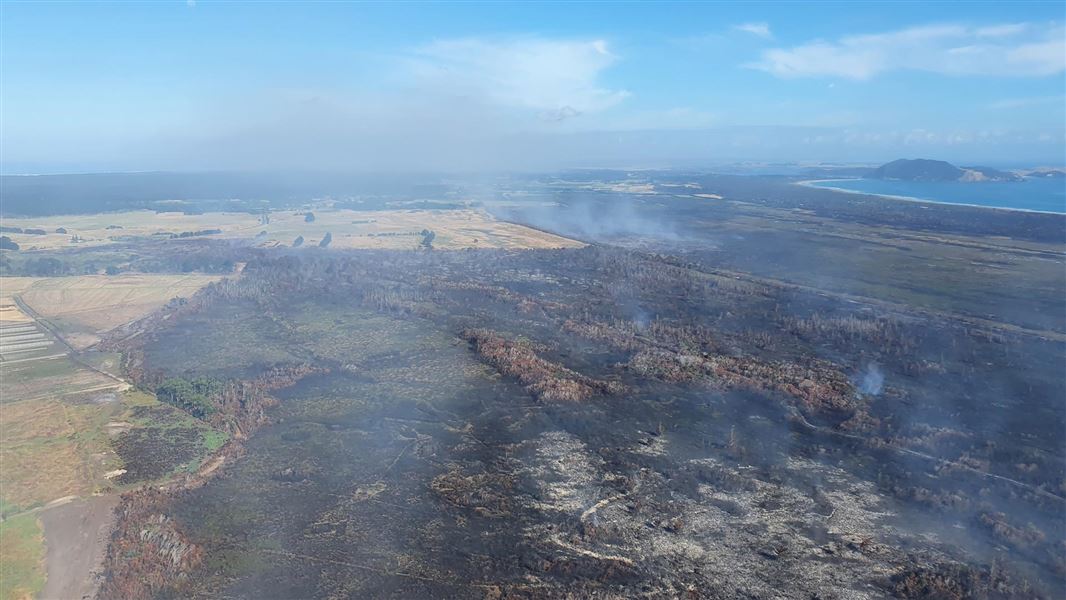Archived content: This media release was accurate on the date of publication.
Date: 16 October 2024
If these losses had to be paid for, the estimated cost would be about $32 million based on current carbon markets.
DOC, working with scientists at Manaaki Whenua - Landcare Research (MWLR), has published a report on carbon emissions from the 2022 fires in the Kaimaumau-Motutangi wetland in Northland and the Awarua wetland in Southland.
Both wetlands are ‘peatlands’ which have an incredible ability to store carbon in peat, built up over tens of thousands of years.
In Kaimaumau the burnt area was over 2,900 hectares, while at Awarua it was 980 hectares.
DOC freshwater scientist Hugh Robertson says calculating carbon loss really brings home the impact of wetland fires on New Zealand’s stores of carbon.
“Carbon emissions from the 2022 fires were large, estimated at more than 515,000 tonnes of carbon dioxide emissions from Kaimaumau and more than 104,000 tonnes from Awarua. All of that carbon was released into the atmosphere.”
MWLR scientist Jack Pronger says the loss of carbon due to the two fires represents about 5% of New Zealand’s annual target for the 2026-2030 emissions reduction period.
“Year-on-year vegetation growth in peatlands removes carbon dioxide from the atmosphere and stores it as peat soil. Fire stops this process by releasing carbon back into the air, which then contributes to greenhouse gas emissions.”
Hugh says peat soils are highly flammable, particularly when they are dried out.
“If we reduce drainage and protect our wetlands, we’re supporting an important nature-based solution to climate change. Re-wetting our wetlands will make them less likely to burn and will reduce greenhouse gas emissions.”
The fires also caused a loss of over 3,000 hectares of native vegetation and damaged habitats of the critically threatened matuku-hūrepo/Australasian bittern and at-risk freshwater fish.
“Recovery and restoration of the Kaimaumau and Awarua wetlands will require extensive weed control, as the bare, burnt ground allows exotic plants to establish,” Hugh says.
Wetlands aren’t currently included in New Zealand’s emissions trading scheme, or carbon accounting, but the research highlights the significant potential of wetlands to contribute to our response to climate change. This potential is also noted in New Zealand’s Emissions Reduction Plan.
View the report: Estimating carbon emissions from peatland fires at Kaimaumau–Motutangi and Awarua wetlands (PDF, 1,324K)
Background information
Extensive peatland fires took place at the Kaimaumau and Awarua peatlands in 2022. In Kaimaumau, the burnt area was over 2,900 ha while at Awarua it was 980 ha.
Both fires were caused by humans. Natural peatland fires occurred in New Zealand before human arrival but the increased frequency due to human activities is concerning.
The report was a collaboration involving DOC and Manaaki Whenua - Landcare Research scientists and supported by local iwi, in particular Ngāi Takoto and Awarua Runaka.
This research is the first detailed study on peatland fire carbon emissions completed in New Zealand.
The report acknowledges a degree of uncertainty in the carbon loss estimates and notes that carbon loss from the fires was probably higher than calculated.
Contact
For media enquiries contact:
Email: media@doc.govt.nz
